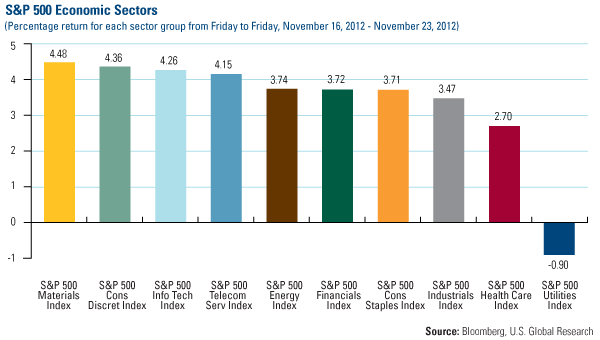U.S. Equity Market (November 26, 2012)
The S&P 500 Index staged a strong rebound from oversold levels, advancing 3.62 percent this week, the largest weekly gain since June. More optimism emerged after President Obama demonstrated confidence on a budget agreement with Congress, national housing data continued to improve, and the holiday shopping season started.

Strengths
- All S&P 500 sectors recovered for the week except utilities, with the materials sector as the best performer. Fertilizers and chemicals stocks led the materials sector because of initial signs of demand recovery due to a sharp decline in potash inventory at Chinese ports. Housing-related stocks such as Lowe’s, PulteGroup, and Lennar led the consumer discretion sector, another outperformer, as October existing home sales, housing starts, and building permits all came out better than market consensus.
- The information technology sector also exhibited strength driven by a fierce rebound of Apple. The computer bellwether regained 8.30 percent this week after an almost 25 percent correction from its late September high related to concerns over its disappointing quarterly results, management reshuffle, and eroding market share of tablets.
- Tyson Foods was the best-performing stock in the S&P 500 this week, up 14.04 percent. The company gave optimistic profit and sales guidance for the next three years on growth in processed items and international sales, in addition to raising quarterly dividends by 25 percent as well as announcing a 10 cents per share special dividend.
Weaknesses
- In general, defensive sectors were laggards this week, a reversal from last week’s trading pattern. Utilities was the only sector which finished the week in negative territory.
- The healthcare sector also underperformed, as St. Jude Medical declined 10.03 percent for the week due to an FDA query on the company’s quality of design, testing, and manufacturing of its Durata cables used for defibrillators.
- Best Buy was the worst-performing stock in the S&P 500 this week, down 14.9 percent, as the company reported a larger-than-expected $10 million loss in the quarter and saw its credit rating downgraded by both Standard & Poor’s and Fitch.
Opportunity
- As fiscal cliff related recession concerns continue to recede and investors look past the immediate economic damages from Superstorm Sandy, the market may resume its historical seasonal strength into year end.
Threat
- Volatility in economic data attributable to Superstorm Sandy in the near term is inevitable and may negatively swing investor sentiment in the interim.











